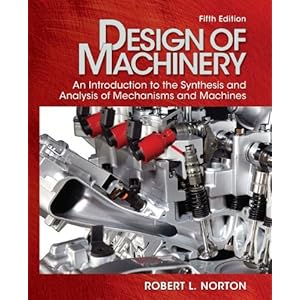Kinematics and engineering
October 25th, 2011 at 9:36 pm (Books, Engineering)
OSU offers a course called ME 412: Design of Mechanisms. Sadly, it is only offered during the winter term, and I am here for the fall term. So I contacted the professor to find out more about what sort of books and other materials the course uses, for my own investigation. Imagine my delight when he gave me a copy of the latest edition of the textbook and sent me on my way!
 This textbook, Design of Machinery, may well be the best textbook I’ve ever read. Really. Unlike some books that pay lip service to being clear and accessible, this text really is clear and accessible. It is also annotated with lots of amusing cartoons and very clearly illustrated examples — the latter being crucial since we’re talking about physical devices and how they move. The book comes with a DVD with animations that I haven’t been able to play with, since it is Windows-only. But, of course, there are linkage animations galore online. And even better is building them yourself, physically.
This textbook, Design of Machinery, may well be the best textbook I’ve ever read. Really. Unlike some books that pay lip service to being clear and accessible, this text really is clear and accessible. It is also annotated with lots of amusing cartoons and very clearly illustrated examples — the latter being crucial since we’re talking about physical devices and how they move. The book comes with a DVD with animations that I haven’t been able to play with, since it is Windows-only. But, of course, there are linkage animations galore online. And even better is building them yourself, physically.
Chapter 1, “Kinematics of Mechanisms,” is charmingly written and touches on the broader subject of what it means to be an engineer, and how one of the biggest challenges is learning how to “structure the unstructured problem” to go from a concept to a problem definition to a solution. One tip the book offers is to use “functional visualization” (meaning, focus on the desired behavior of the solution, but no one kind of “embodiment”) so as not to limit your creativity and be restricted by a specific kind of solution early on. It also encourages you to make cardboard models of linkages that you design (as above) — a philosophy I think makes a lot of sense.
The chapter also includes the text from a paper given by George A. Wood Jr. titled “Educating for Creativity in Engineering.” Two of my favorite quotes from the paper are, “To me, the creative moment is the greatest reward that the profession of engineering gives,” and “If a person decides to be a designer, his training should instill in him a continuing curiosity to know how each machine he sees works.” Yes! Yes!
On a more concrete level, I learned that kinematics is “the study of motion without regard to forces,” while kinetics is “the study of forces on systems in motion.” The first half of this book focuses on kinematics, reserving forces for the second half. I can already tell that kinematics alone provides ample material to keep me busy!
“Once you become familiar with the terms and principles of kinematics, you will no longer be able to look at any machine or product without seeing its kinematic aspects.”
It’s already happened. At a conference last week, after ironing a shirt in my hotel room, I sat down and drew my first kinematics diagram — of the ironing board.
I’ve already started working through Chapter 2, “Kinematics Fundamentals,” which is fascinating but slower going, as it’s dense with new information, terms, and concepts for me. But I’m already impatient to get to the end of this chapter, where there are 15 pages of problems to do! Starting with… drawing kinematics diagrams of familiar objects like ironing boards. Ooops, jumped the gun on that one!